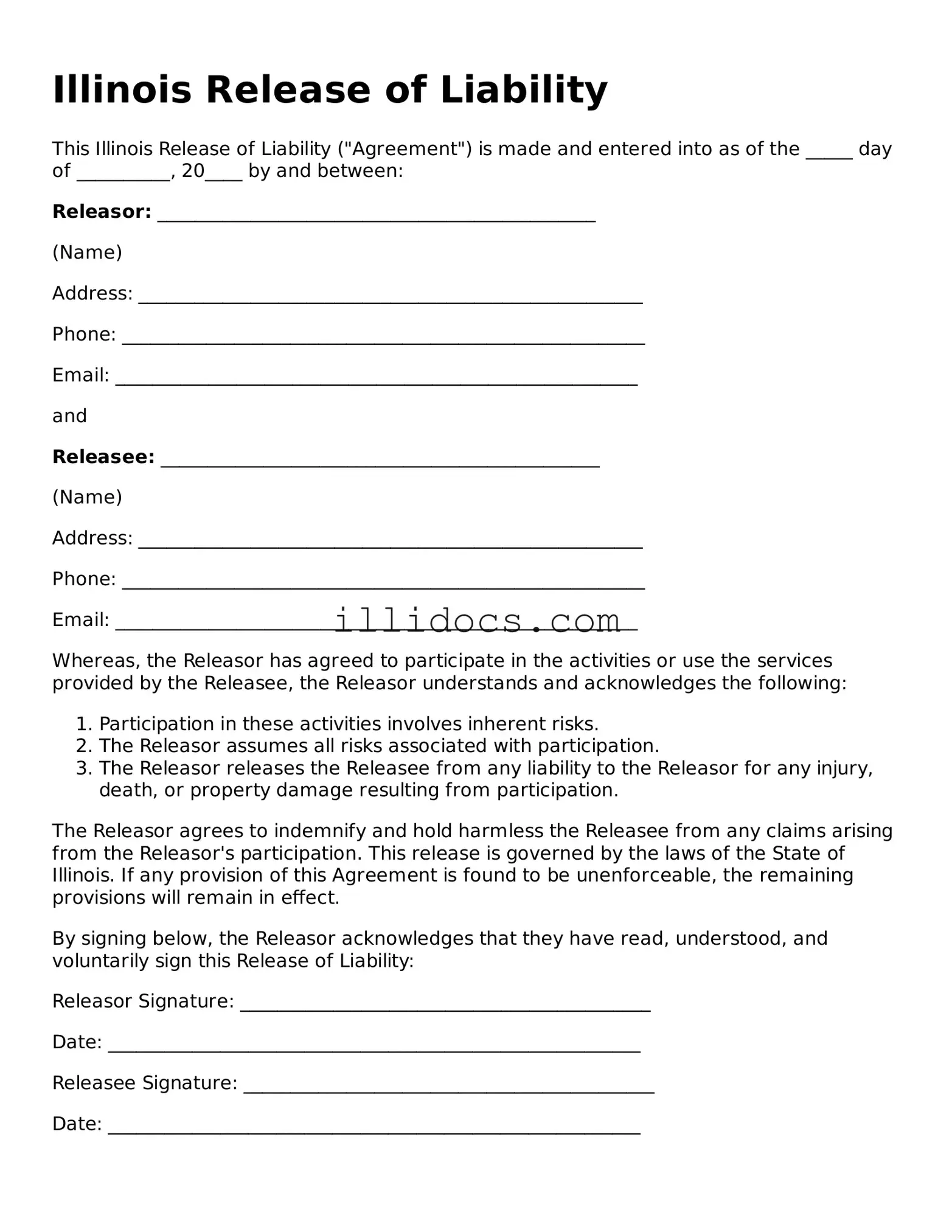What is an Illinois Release of Liability form?
An Illinois Release of Liability form is a legal document that protects a party from being held liable for any injuries or damages that may occur during an activity or event. By signing this form, participants acknowledge the risks involved and agree not to hold the organization or individual responsible for any accidents or injuries that may arise. This form is commonly used in recreational activities, sports events, and other situations where risks are present.
Who should use a Release of Liability form?
This form is typically used by organizations, businesses, or individuals who conduct activities that involve potential risks. For example, sports leagues, fitness instructors, event organizers, and recreational facilities often require participants to sign a Release of Liability form. It helps ensure that all parties understand the inherent risks and agree to assume responsibility for their own safety.
Is a Release of Liability form legally binding in Illinois?
Yes, a properly drafted and executed Release of Liability form can be legally binding in Illinois. However, it must meet certain legal requirements to be enforceable. These include clear language, voluntary agreement, and the understanding that the signer is waiving their right to sue for negligence. Courts may review the circumstances surrounding the signing to determine if the release is valid.
Can a minor sign a Release of Liability form?
Generally, minors cannot legally enter into contracts, including a Release of Liability form. However, a parent or legal guardian can sign on behalf of a minor. This signature acknowledges the risks involved and agrees to the terms of the release for the minor participant. It's important to ensure that the form is clear and understandable for both the guardian and the minor.
What are the risks of not using a Release of Liability form?
Without a Release of Liability form, organizations and individuals may face significant legal exposure. If an injury occurs during an activity, participants may have the right to sue for damages, including medical expenses and pain and suffering. This can lead to costly legal battles and financial liabilities. Using a release helps mitigate these risks by clearly outlining the responsibilities of each party.
Can a Release of Liability form protect against all types of claims?
No, a Release of Liability form cannot protect against all claims. While it may cover general risks associated with an activity, it typically does not shield against gross negligence, willful misconduct, or intentional harm. Courts may also scrutinize the language of the release to ensure it is not overly broad or vague. Therefore, it’s crucial to draft the form carefully to reflect the specific risks involved.
How should the Release of Liability form be presented to participants?
The form should be presented in a clear and straightforward manner. Participants should have adequate time to read and understand the document before signing. It’s advisable to explain the contents of the form and address any questions they may have. This transparency helps ensure that participants are fully informed about the risks and their rights before agreeing to the release.
What information should be included in a Release of Liability form?
A comprehensive Release of Liability form should include the following key elements: a clear statement of the activity, a description of the risks involved, an acknowledgment of those risks by the participant, a waiver of liability, and space for the participant's signature and date. Additionally, including contact information for both parties can be beneficial for record-keeping purposes.
How long is a Release of Liability form valid?
The validity of a Release of Liability form does not have a set expiration date. It remains in effect as long as the activity for which it was signed is ongoing or related to the specific event. However, if there are significant changes to the activity or if new risks are introduced, it may be wise to have participants sign a new form to ensure continued protection.
Can a Release of Liability form be revoked after signing?
Once a Release of Liability form is signed, it generally cannot be revoked unilaterally. However, if a participant can demonstrate that they were coerced into signing or did not fully understand the terms, they may have grounds to challenge the validity of the release. It’s important for organizations to ensure that participants enter into the agreement voluntarily and with full comprehension of its implications.
